
It’s not an easy task to ask for money, especially when you don’t have any product or service to offer in return. As a result, when it comes to executing successful email marketing campaigns, nonprofits experience their own unique difficulties.
- How can you ensure that your fundraising emails get read and opened?
- What are the most effective words and phrases to use?
- How can you boost the response rate?
If this describes your situation, we’re here to help you with the best email marketing tips for nonprofits.
Before we get to the main article, why should nonprofits take email marketing as a vital aspect of their marketing strategy?
Why email marketing is important for nonprofits
Email is the only channel that can help you stay on top of your workload while also allowing you to communicate with your supporters. The following reasons outline why you should start email marketing for your organization:
Email is budget-friendly
Efficiency is vital in a field where budgets are usually limited. Email can be a cost-effective and results-oriented communication channel for Nonprofits.
There’s no need to deal with the trouble and expense of sending out appeals and updates to supporters. A lot of email marketing software allows you to get started with email marketing for free.
But does email marketing work?
Email generates the highest return on investment among all of the digital marketing channels. In the nonprofit sector, organizations collect an average of $78 for every 1,000 fundraising emails.
Personal and effective communication
While nothing matches having a one-on-one chat with a supporter, email marketing can provide the next best thing.
You’re probably working with a small budget as a nonprofit. That way, you won’t be able to interact with each contact as your supporter base expands.
Email allows you to reach out to a larger number of people while keeping a personal touch. Unlike social media, emails are delivered directly to the contact’s inbox. Your email marketing software will gather various a lot of data about your contacts, allowing you to apply email personalization techniques to make sure your email content is relevant.
Increases engagement
Email allows you to maintain a direct channel of communication with those who are interested in your topic, enabling you to continue the conversation and grow the relationship. You can express your gratitude by sending a timely thank-you note and incite more support by providing updates on your work and options to get involved.
Although there will always be arguments over the usefulness of email vs. direct mail for NGOs, however, the trend toward digital communication is unquestionable.
Online giving increased by about 21% in 2020 compared to the past year and by more than 32% over the last three years.

You can build a streamlined donor experience with regular emails to enhance response rates. Instead of filling out and returning the donation form, the supporter simply presses a button on their device to donate.
- You can also read our article on ‘Mailchimp alternative for nonprofits.’
5 email marketing strategies for nonprofits
From audience management to campaign execution, the steps discussed below will lead you through creating an efficient email marketing strategy for your nonprofit.
1. Build a solid email list
While crafting an email, apparently, you spend a lot of time and energy and the last thing you want to do is send them to the abyss.
That’s why building a solid email list is the foundation of any effective email marketing strategy. An effective campaign begins with a strong email list. It’s not just about how much data you have; it’s also about how solid it is.
You might think buying a nonprofit email list could be a shortcut to growing your email list. The reality is, that you’ll get better results with an insignificant audience who are actually interested in your work.
Sending unwanted emails to folks who have no sympathy for your cause or organization won’t get you anything. So how can you build a quality email list that will be useful for your organization in the long run?
Fortunately, you don’t have to worry about it. Click here to find out some of the proven steps to collecting email lists.
2. Build engaging campaigns
Once you’ve built your contact list and are ready to go, now it’s time to get creative with your email design and content. To achieve the best results, make sure they look excellent and your content is engaging.
Here are the best practices for nonprofit email design:
- Maintain a brand image: Design an email template that aligns with your firm’s rules and guidelines. Then, utilize it as a cornerstone for various campaigns to keep resemblance
- Use images sensibly: Real photographs of your work in progress will help your audience feel connected. However, images alone will not be enough to deliver your message. There are chances some of your contacts won’t be able to see them (for instance, if their email service blocks photos or if they use a screen reader)
- Keep it short: Rather than annoying the readers with too much text, utilize buttons to redirect them to more resources
- Make them reader-friendly: Write short paragraphs and separate content with subheadings and dividers, so the readers can easily digest your message.
- Focus on mobile-friendliness: Make sure your design works on mobile devices too. Send test emails or if your email tool has the preview option, use it.
Suggestions for high-converting nonprofit email content:
- Tell a story: Facts alone will not help you connect with your audience. Real-life stories that are relevant and make people feel something will elicit the best response from them.
- Build trust with a known sender name: When contacts recognize the sender of an email, they are more likely to open it. So, it’s essential to specify your organization’s name in the sender’s information.
- Maximize open rates with a catchy subject line: It should explain what’s inside and why recipients should be interested. Email subject line strategies such as highlighting seriousness and employing powerful, emotion-packed verbs (“fight, “save,” “change,” etc.) are pretty effective for nonprofits.
- Make an explicit request: Each email you send should have one major call to action. Make a visible button that highlights what you want the reader to do, such as “give now” or “register to volunteer today.”
3. Send to the right persons at the right time
“How frequently should a nonprofit send emails?” —is a common issue that arises.
According to global data from 2019, the frequency of email sending among organizations varies. It was shown that 35% of those who send email updates to donors do so monthly, 30% quarterly, and 13% weekly.
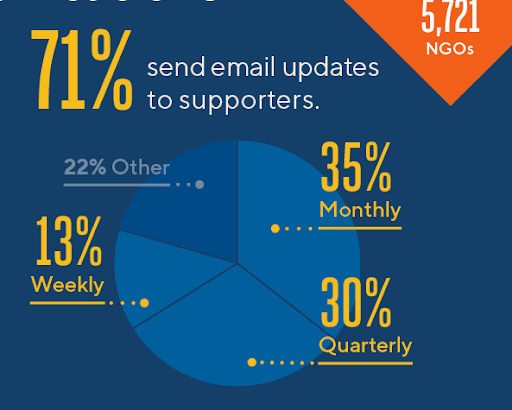
It’s a fine line to walk when it comes to email frequency. On the one hand, you don’t want to flood your subscribers’ inboxes with messages. You, on the other hand, have something valuable to offer to them.
What’s your response?
– Send only to people who are interested!
You can avoid bulk email campaigns by segmenting your email list and instead focus on the people who are most likely to respond. As a nonprofit, you can categorize your contacts based on the following criteria:
- What type of helper they are, for instance, are they an event attendee, donor, volunteer, or fundraiser?
- If they’ve donated recently or if they’re a regular donor
- If they’re a VIP or high-value supporter
- Which of your initiatives or aspects of your work have they backed or shown interest in?
- Their location
Email automation is another option to ensure that your messages are relevant by triggering campaigns when a contact performs a specific action or fulfills predefined criteria.
Possible synopsis includes:
- Welcoming new helpers, like first-time donors, volunteer signups, or email subscribers
- Attempting to convert one-time donors into frequent ones
- Getting in touch with people who haven’t contributed in a long time, such as lapsed donors
4. Evaluate your results
It’s necessary to monitor campaign performance once they’re up and running. This will assist you in determining what works best for your target audience and fine-tuning your strategy accordingly.
Some important metrics to follow are:
- Open rate: The percentage of individuals who opened your email.
- Click through rate: The percentage of people who got engaged with the content by clicking a link in your email after opening it.
- Unsubscribe rate: The number of people who unsubscribed to get your email by clicking the unsubscribe link. Make sure the content is relevant and the subscribers only receive what they signed up for to keep this as little as possible.
- Revenue generated: The amount of revenue your campaign generated. All other metrics mean nothing if this isn’t as good as you expect it to be!
Click Rate vs. Click-Through Rate: What’s the Difference?
If you’re still indecisive about which strategy to pursue after analyzing the results of various campaigns, A/B testing can help. This allows you to test multiple versions of the same email to evaluate which one performs the best.
4 excellent nonprofit email examples
1. Welcome emails
After signing up for newsletters, 75% of new members expect to receive a welcome email. So, it’s necessary to make a great first impression.
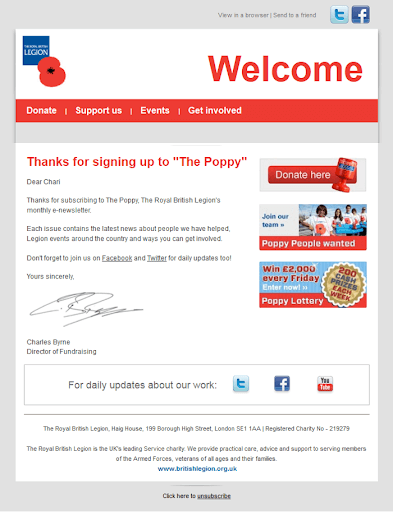
- It takes advantage of customization, which greets new subscribers by name
- It has social networking buttons, which makes it easier to engage people across multiple platforms
- The email includes multiple appealing CTAs
Usually, we suggest placing only one CTA per email. However, when you don’t know much about a new member, it’s a good idea to give them a few options in a welcome email.
Make sure you keep note of which CTAs they click and include that information in their profiles, or you’ll be wasting important data!
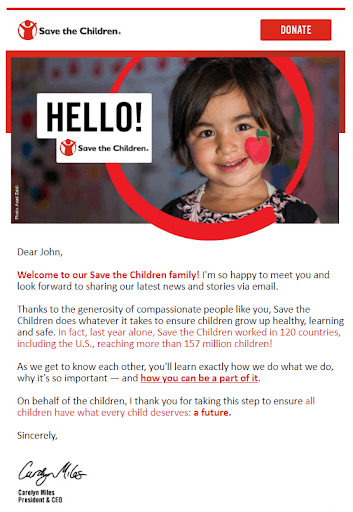
By displaying it as a button, the “DONATE” CTA has been made more noticeable than the other typical CTAs.
If you’re using WordPress, it’s possible to send custom welcome emails from WordPress. Check out our tutorial to learn how you can do it!
2. Newsletters
Newsletters are the pillars of your nonprofit email marketing strategy. They are a great way to stay in touch with your supporters and keep them updated.
The focus should be on informative content rather than promotional stuff. Although you’ll want to show what’s new at your organization, highlight the contribution of your supporters instead of making it all about you.
Here are some ideas for your nonprofit’s email newsletter:
- Your experiences from your fieldwork
- If you have a blog, you can link educational content relevant to your mission
- Bring a volunteer, staff member, or a supporter to the spotlight
- Updates on your current campaigns
- Future events
- Opportunities to volunteer
- Themed based on current awareness and holiday events
Check out this newsletter to get an idea of what this might look like in reality:

The following are some of the aspects that set this nonprofit email apart:
- The newsletter’s branded header makes it easy for readers to recognize it
- The content is a wonderful combination of informative and actionable approaches to help the cause
- Bulleted points made it realistic by explaining how your money will be spent and why you should donate.
3. Targeted appeals
What makes a great appeal? Stories have the power to move people.
“Making your communication more personal will increase the emotional appeal, and thus the likelihood of a donation. Saying you want to feed, cloth, or educate Susie, a 5th grader in your district, is more powerful than saying you’re raising money to help kids in general,”
– Brian Dooley, the founder of Independence Digital.
Don’t bore your readers with statistics and numbers, as well as all of the programs your NGO implements. Tell a story about a crisis you helped someone or a family with. Make your readers know that their donations will help your organization reach out to more helpless people like the one you’re featuring.
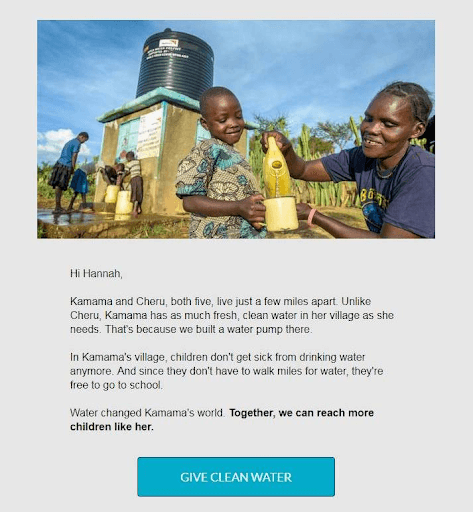
In this newsletter, readers come to know about a 5-year-old girl, called Kamama. Her life was changed for good when World Vision provided clean water to her village. One influential image and six simple lines were used to deliver this message.
“Give Clean Water” is the Call to Action here rather than “Donate.” Readers are completely aware of exactly what problem they are helping to solve when they donate to World Vision.
Another way is to highlight the potential impact of the donor’s action.

This email generates a sense of urgency and specific need because it portrays the case of an individual child in inevitable trouble.
Focus on the impact that a donation can do, as this will provide readers with a compelling reason to take action right away.
4. Thank you emails
When someone makes a donation or joins your mailing list, they are doing something unselfishly for a noble cause. So make sure you express your gratitude towards them!
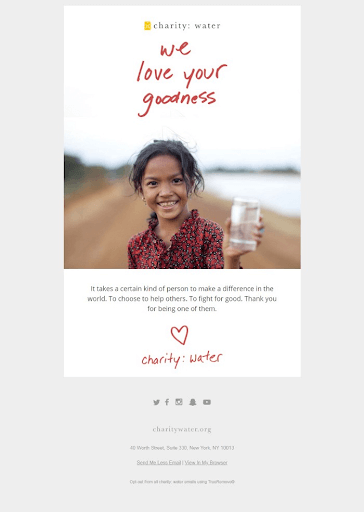
This is a thank you email from Charity: Water which may seem basic yet is remarkably effective. It shows gratitude and makes the recipient feel good about themselves. This is a significant psychological factor of philanthropic giving.
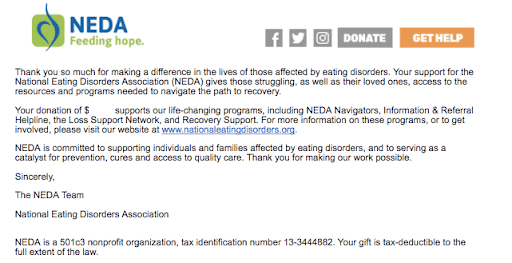
On the other side, this thank you email uses the opportunity to stress the impact the donor’s contribution will have. It also includes a button that says “Get Help.” This is useful since it is crucial to remember that some people may join your email list because they seek your help.
5. Re-engage donors
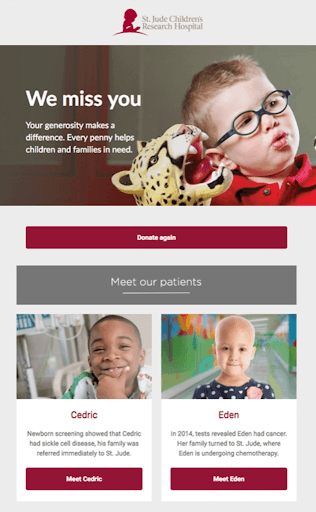
Re-engage a subscriber who has stopped responding to your emails by reminding them why they support you. With a strong CTA, like the one seen above from St. Jude Children’s Research Hospital, they are more likely to donate. It also emphasizes the urgent need for help by showing the children’s conditions.
Subscriber churn happens on all lists at some point, but you should consistently try to re-engage folks who want to unsubscribe.
Start your next nonprofit email campaign today
Email can help you spread the message and engage supporters, whether it’s a donation request, a campaign for a future event, or an update on your latest work.
For a strong yet easy-to-use solution for managing your nonprofit’s email marketing from WordPress, check out FluentCRM. This is a free-to-start email marketing plugin that helps achieve all your non-profit email marketing goals.
Use signup forms to build your email list, create campaigns in minutes and segment your contacts to send out the right content to the right audience. Our free subscription gives you access to all of this and more, as well as unlimited contacts, and sends unlimited emails every day.



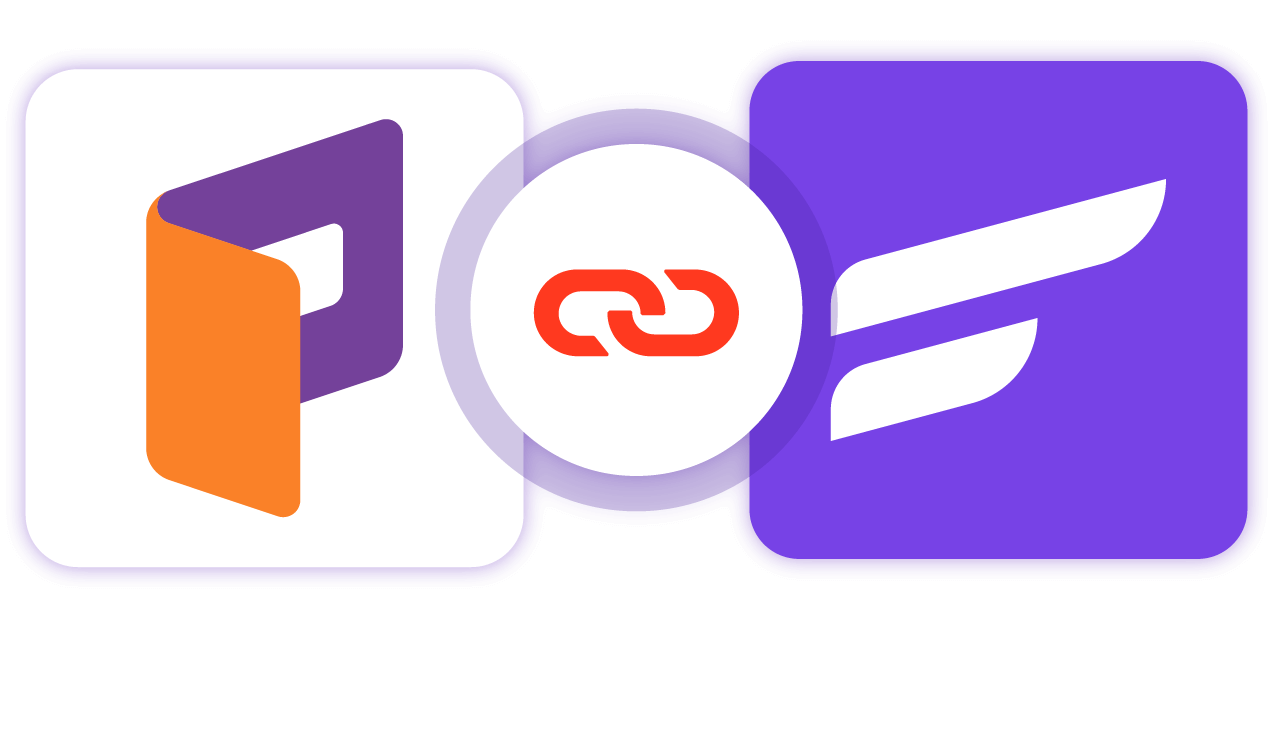


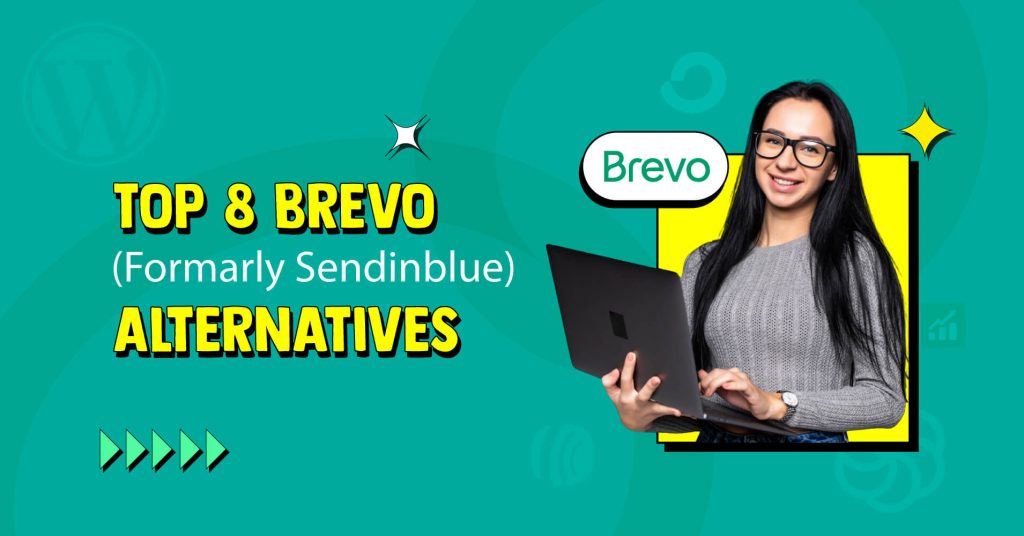




Leave a Reply